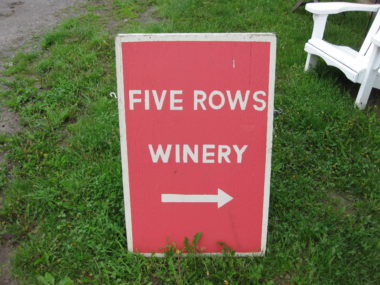When Life Gives You Lemons…
Pruning in shorts? So much for those ultra-thermal, -70°C rated “Tarantula” boots my Dad got me for Christmas. They’re still in the box. Sap is gushing from the tips of newly pruned grapevine canes and there are pink swollen buds on my Magnolia tree – it’s only March 20th. It was officially winter…yesterday.
Vineyard managers across the region are scratching their heads while sporting cautious grins. They should be tremendously excited about how early this growing season promises to be. Three weeks early is not out of the question at this point. But our enthusiasm is guarded. There will no doubt be multiple frosts between now and the end of May. The extremity of those frost events and just how advanced the buds will be when they happen are nervous variables yet to be determined.
So we sit on a precipice of possible greatness. A vintage for the ages or an apocalyptic frost event that fries most of our delicate shoot growth. At least I can go golfing tomorrow to calm my nerves.
Shifting gears, it’s very exciting to have our 2011 Sauvignon Blanc featured in the April/May issue of Vines magazine. To be included in the article alongside notable Sauv Blanc producers like Hidden Bench and Creekside is a thrill for us. The photo shoot at the Botanical Gardens was a fun change of pace and really symbolizes the vibrancy of Niagara Sauvignon Blanc. I don’t know how they talked me into a few of those poses, but you know what they say, “When life gives you lemons…”
I’ve received numerous inquiries about the barrel sample of 2011 Sauv Blanc that was reviewed in the article, some expressing horror that they had missed a release notice. Not to worry – all 100 cases will be bottled on April 2nd and hopefully ready for release by May 1st. Please let me know if you’d like to reserve a six bottle case (wes@fiverows.com).
An Ode to Oak
I’m generally not an emotional guy. Why then, am I having such a difficult time parting ways with the first two barrels that ever held my wine?
The time has come to cruelly determine which of our used oak barrels must be sent out to pasture, literally. I’ve been through wars with these veteran barriques. They’ve seen good wine, bad wine and everything in between. Some have been a working fixture in our barn for eight years. Now you must decide which old soldiers can no longer carry out their job, good luck with that! This unceremonious send-off just doesn’t seem to befit such a valuable part of our winery.
Good oak is the winemaker’s not-so-secret weapon. Sure they are expensive (our largest capital expense from year to year) but they are essential. I’ve come to learn that new oak should never be taken for granted and never be used in overabundance. Too much new oak can mask and possibly ruin the fine subtleties of an aging wine. Restraint should always be exercised.
My attachment to each individual barrel is surely due to the small size of our operation. Over time I become acutely aware of their “personalities” through weekly tasting and topping regimens. Some are big softies, while others are boldly complex. Some barrels make the retirement decision easy for me. No amount of sterilization can rid them of the contaminants they’ve accumulated over the years, so out the door they go. But what about the barrel who’s only knock is it’s old age and bland neutrality? That is the dilemma staring me in the face right now.
Back in 2004, under the guidance of Creekside Estate Winery winemakers Rob and Craig, I assembled a two barrel blend of Cabernet Sauvignon sourced from our vineyard. With a pool of twelve barrels to choose from, we experimented with 50L from here and 25L from there until we all agreed upon a blend that I could confidently open a winery with. It was decided that the wine should be housed in a couple of beautiful, two year old French oak barrels made by Burgundian cooper Claude Gillet. The wine would stay cloaked in these barrels until 2006, when we bottled our first Five Rows release – the 2004 Cabernet Sauvignon.
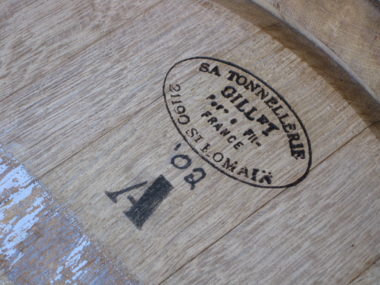
Those same two Gillet barrels proved tremendously versatile with each successive vintage of Five Rows Cab Sauv. What they lost in intensity each season, they gained in character and elegance. This past week I racked some 2009 Cab Sauv from the Gillet twins and was pleasantly surprised at the finished product. I didn’t hold out much hope for the 2009 Cab at this time last year, but an additional 12 months spent soothing in neutral oak really did the trick. We’ll bottle the 2009 Cab Sauv this spring.
So there they sit after ten long years of service, empty and willing…but sadly there is no wine to fill them. Now the decision is upon me. No more stalling filibusters, it’s time to take these two out behind the barn and “pop the bung” for good. I swear I’d have an easier time putting down Old Yeller. At least he had rabies.
One day soon I’ll crack a bottle of 2004 Cab Sauv in their honour. Few times will I enjoy a bottle more.
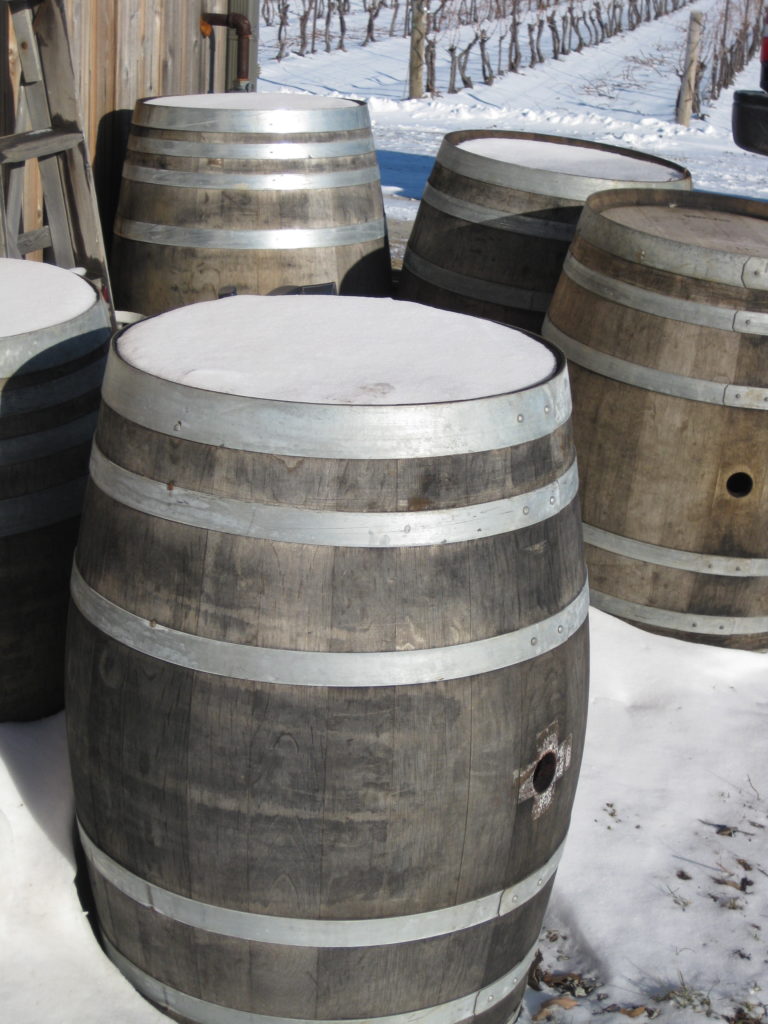
A Dinner With Friends
A winemaker prepares for a “Winemaker’s Dinner” with the hope that his or her wines will show their best and contribute positively to the evening’s festivities and fare. My pre-dinner jitters were immediately settled when I walked into Treadwell’s on Saturday and was greeted by so many familiar faces. It was like walking into the warm atmosphere of a family dinner.
As we drove to Port Dalhousie, I’d managed to convince myself that by now people must be sick of hearing me rattle on about leaf-removal techniques in Pinot Gris or the benefits of whole-bunch pressing in Riesling, but surprisingly that was not the case! People expressed genuine interest in hearing the behind the scenes viticultural and enological practices that we employ at Five Rows. I found this very encouraging and flattering. But let’s not kid ourselves, the people came to hear Howie and Wilma tell their stories – and those two never disappoint!
As one might anticipate, the true star on this night was the food. James, Jason and staff completely outdid themselves, coming up with a stunning menu that left everyone raving. The liveliest debate was reserved for deciding which course and pairing was our favourite. I was partial to the Pinot and Tuna.
It’s always amazing to me that our wines just seem to smell and taste more intense when served at Treadwell’s. Perhaps it’s the heightened anticipation of the senses or maybe its the proper serving temperature and stemware. Whatever it is, I was relieved that each wine seemed to go over well.
I decided to use this group as guinea pigs (they seemed rather willing) to demo a blending trial of our yet to be released 2009 Pinot Noir. The 2009 vintage was a dream for Niagara Pinot growers, who were treated to perfect ripening conditions for a change. I put together a blend of 85% 2009 Pinot and 5% from each of three different barrels of 2010 Pinot. The blend composition was determined based on some areas where I felt the wine could use a lift. One of the 2010 barrels was Clone 777 (first crop), which added an interesting fresh raspberry dimension to the aromatics. It plays well off the typical burgundian notes always present in the Clone 115 Old Vine Lowrey Pinot.
We decided to pit this 2009 blend against our 2007 Pinot Noir to see how it stacked up. I felt that the 2007 had gained some aromatic complexity since I last tried it, but it’s lively tannins tell me that this wine could still benefit from a bit more time in the cellar. It was agreed that the 2009 blend really showed promise, and some people even preferred it over the 2007! We will bottle the 2009 (maybe this exact blend) in April, with a release anticipated for early in the summer.
Thanks to all who attended for making this such a memorable experience!
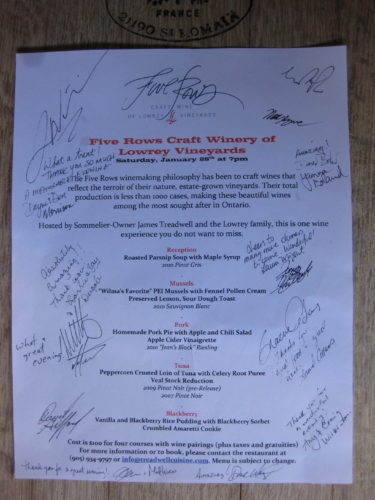
Winemaker’s Dinner
We are currently finalizing plans for our second annual Winemaker’s Dinner to be held once again at Treadwell Farm to Table Cuisine in Port Dalhousie. For those interested in attending, it will take place on Saturday, January 28. I’m told that most of the seats are spoken for by returnees from last year, but there may be a few spots still up for grabs. Best to contact James ASAP (905-934-9797).
The menu and wine pairings are still being conceptualized. You’d be amazed at the amount of thought and debate involved in this process! I don’t want to give too much away, but I may have convinced my mother to part with our final few bottles of 2010 Sauvignon Blanc, 2010 Pinot Gris and 2007 Pinot Noir to pour for the occasion. I can’t think of a better curtain call for these wines.
Over the next couple of weekends (Jan. 14-15th and the 22nd) our barn will be open for tastings from 11-5. We welcome anyone planning to attend the Icewine Festival to stop in for a complimentary sample of our 2009 Single Press Cabernet Sauvignon Icewine.
I’m proud to say that my little sister will be getting married on January 21, so we’ve elected to close Five Rows for the day and use the barn for pictures and festivities. Congratulations Catherine and Steve!
Housekeeping
Now that I have a few moments on my hands, it’s probably a good time to do a little housekeeping and update everyone as to which wines we currently have available. After a busy summer, I regret to inform that the 2010 Sauvignon Blanc and Pinot Gris have officially been sold out, but the following two wines can now be enjoyed:
2008 Five Rows Cabernet Sauvignon
Much will be written about the fabulous “Bordeaux” reds from Niagara in 2007 and 2010. Little to nothing will be written about the late-ripening reds from 2008 and 2009. For that reason, I am perhaps more proud of the Cabernet Sauvignon we grew and vinified in 2008, than any other wine we’ve produced.
Trying climatic circumstances called for extreme measures in the vineyard. As the harvest approached, it became apparent that early season thinning and leaf removal efforts were not going to cut it in 2008. We doubled our efforts and dropped more fruit than I am normally comfortable with. The winery I envisioned, however, could only be built on these tough decisions.
On October 24th we harvested only 68 picking boxes from two full rows of our Clone 169 Block. The fruit was very clean and showed surprising ripeness in both flavour and tannin for its 22.5 degrees Brix. It was a pleasure to pick and process. We went on to harvest 82 more picking boxes from our “Old Block” on November 2, after extracting as much life as we possibly could from the dwindling foliage.
The two blocks of fruit were processed into separate one tonne bins, and cold-soaked on the skins for five days. I decided to try a new yeast strain, Zymaflore FX10, with the slightly riper Clone 169 fruit. FX10 is known to produce wines defined by their elegance through a combination of structure, volume on the palate and intense colour. The Old Block fruit was fermented with F15, a new favourite yeast of mine after a successful experiment in 2007. Both ferments concluded uneventfully after six days with peak temperatures around 30C. The wine was left on the skins for a further 4 days of post-ferment maceration before pressing.
Malolactic fermentation was carried out in 1 new and 3 older French oak barrels. It was left in oak for 24 months before final blending and bottling on April 6th, 2011. Based on previous vintages, I felt that two full years spent in barrel and resisting the temptation to use more new oak were essential to properly aging this Cab Sauv.
The two blocks produced remarkably different wines, ultimately leading to an interesting, complex blend. I’m always amazed at the differences between individual barrels of wine from the same vineyard. Is it due to terroir, clonal difference, oak influence, yeast strain, fermentation dynamics or all of the above? As the years go by I hope to peel back the layers and discover just what makes our Cab Sauv end up the way it does.
The 2008 is an elegant wine, with an aromatic intensity that is unexpected by many who’ve tried it. It has a delicate, soft mid-palate that suggests early drinkability, unlike 2007. It is very reminiscent of the 2004 Five Rows Cabernet Sauvignon at this early stage.
2010 Five Rows Riesling “Jean’s Block”
The 2010 vintage was a hot one. Niagara vineyards amassed more growing degree days than any year in current recorded history. This is perfect for ripening reds but can present challenges to producing crisp, aromatic whites. It was very easy to produce “flabby” and “blousy” white wines in 2010 if grapes were over-thinned, over-exposed to sunlight or left hanging too long.
We harvested and pressed about one tonne of Riesling from Jean’s Block on Septmeber 30, a full two weeks earlier than in 2009. The picking decision was based strictly on acid and flavour. Around mid-September the grapes had plenty of sugar (19 degrees brix) to make the style of Riesling I was after, but it took a while to coax out the wonderful flavours I remembered from last year. Waiting too much longer to pick was a risk, however, as acid levels were declining quickly in the late summer sun. So September 30th was the day I pulled the trigger.
Following the addition of pectinase enzyme, pressed juice was cold-settled at 4 degrees Celsius for two days. The clear rackings were then inoculated with W15 yeast, a great choice for optimizing bright fruit characters in aromatic whites. It’s also a good cool-fermenter, able to withstand temperatures as low as 10C.
I was able to stretch the ferment over two months at an average temperature of 11C. It was stopped at a specific gravity of 1.005, a level that I felt exhibited balance to my palate. You have to be careful when stopping a ferment for off-dry balance as sometimes the carbon dioxide bubbles can lead to a raised perception of acidity, tempting you to halt the ferment too soon. My rule of thumb is to taste often until I find the right balance, then wait 12 hours before killing the ferment. It seems to have worked for most of my whites thus far.
Over the course of the next three months, the wine was cold stabilized, fined with bentonite and sterile filtered. 78 cases were bottled on April 6, 2011. As with the 2009, this Riesling went through a lengthy period of bottle shock before I was comfortable that it had returned to the wine I remembered in tank. Consequently, we waited to release the Riesling three months later than our other 2010 whites. In the end this proved advantageous, as the 2010 Sauvignon Blanc and Pinot Gris both sold out very quickly.
Aromatics: citrus, peach, floral notes
Palate: a surprisingly weighty Riesling, it has ample acid to balance the slight amount of residual sugar; pleasing minerality and fruit characters
Price: $25.00/bottle
Production: 78 cases
2009 Cabernet Sauvignon Icewine Release
As winter draws near, it’s fitting that our 2009 Cabernet Sauvignon Icewine is finally ready for release. The bottles are signed, the labels have been folded and the wine is drinking beautifully!
Excitingly, we were just informed that this wine has received a silver medal in the Icewine category at the 2011 Canadian Wine Awards. Full results will be made public in the December issue of Wine Access. I must admit that this was not an easy wine to make (it drew my ire on many occasions) and to be recognized in this manner is especially gratifying.
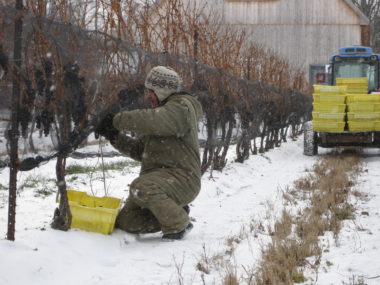
I remember the day we harvested this fruit very fondly. After an evening of perfect freezing conditions (-12 degrees Celsius) it was decided that we would hand pick five rows of specially selected Clone 169 Cabernet Sauvignon. A beautiful day unfolded before us, with a light snow gently filtering the weak rays of winter sun. Having spent the last three months fending off voracious flocks of starlings, the relief of harvesting was palpable that morning, and probably helped us brave the cold.
I quickly learned that everything involved in Icewine production is slow and difficult. Pressing was a very long and drawn out process, but we were thankful for each singular drop of juice that slowly dangled and fell from the press spout. The fermentation was also a marathon, as yeast don’t normally take kindly to such extreme conditions. Proper nutrition and attention to fermentation dynamics were of the utmost importance. Slowly but surely the sugar became alcohol and the amazing Icewine flavours began to reveal themselves. The goal was to produce an Icewine that would not be perceived as being “too sweet” and I think we achieved that.
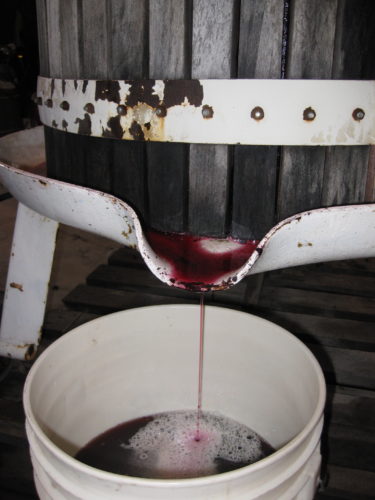
The challenge continued when it came to filtering and bottling this lucious, thick liquid. In fact, it required as many pads to filter this measly 270L as I used for the rest of my entire 2009 vintage! Bottling into narrow 200ml glass was a treat as well. First the corks wouldn’t fit properly, then the bottles started tipping over on the filling line. Keep in mind that any spillage of icewine is magnified many times simply due to it’s scarce supply.
Perhaps the easiest and most enjoyable part of this wine was the label design. It’s a fun process and I’m always impressed with the original concepts that are born on the magic blackboard at Insite Design. They always seem to come up with ways to make my wines feel special. For a sneak peek at the package concept of this wine click here.
Many times over the course of this Icewine experiment I promised myself that under no circumstances would I ever do this again. Based on the tremendous response to this wine, however, I may now have to eat crow and reconsider.
Sometimes crow tastes good.
The Weight
Defining a personal “style” of winemaking has always been a difficult proposition for me. I still consider myself an unexperienced rookie, then I glance at the calendar and realize I’ve been at this gig for quite a while. As visions of past vintages scan by quickly in my mind, I recall my early days in Nova Scotia through my time as Viticultualist at Creekside Estate Winery. I’m suddenly astounded when it hits me that I’ve been making wine for Five Rows since way back in 2004! Has it really been that long?
Questioning my personal style is standard practice around this time of year, as I debate what tweaks to make in each of our of 2011 wines. The quandary is whether to mess with the formula that has produced a certain style of wines people have come to expect and enjoy. The safe move is to keep thing status quo, but that’s not why I got into this. I want to push envelopes and ultimately change perceptions of St. David’s Bench Terroir. But what if I screw it up?
I present the case for my 2011 Sauvignon Blanc. Previous successful vintages (2007-2010) could be chalked up to equal parts fruit quality, terroir, and winemaking technique. Beautiful late-summer weather assured the success of this year’s crop, with ideal acid and sugar parameters, ripe seeds and classic Lowrey Sauv Blanc flavours.
Do I treat this fruit the exact same way as I did in previous vintages or do I make a few subtle changes to the winemaking protocol in an effort to improve? “Fence-sitter” Wes says, “Don’t rock the boat, people like it as is. There is no need to alter the oak to stainless steel ratio, yeast type, fermentation temperature, and residual sugar content if you don’t have to.”
“Devil May Care” Wes says, “Deep down you know there was some room for improvement in the 2010 Sauv Blanc (and I don’t care if it sold out already!). Trust your instincts and do what it takes to make the wine you envision. When you first started making wine you didn’t care about defining a style, you just wanted to achieve the best possible representation of your terroir. Ultimately, if you like the wine, so will everyone else.”
I chuckle at the irony when I read this over and tend to agree with “Fence-sitter” Wes, but all kidding aside, I feel it important to proceed without the boundaries of a defined style in all my wines. The success or failure of a wine should not be judged by public perception or sales figures, but on whether the winemaker achieved their goal.
2011 Vintage Update
Call me Chicken Little.
At the first sign of rotten berries and fruit flies in our Pinot Noir I run to my father and proclaim, “the sky is falling”. I rattle off all the jobs that need to be done IMMEDIATELY: gotta get the bins ready for harvest, gotta cut the rot out, gotta check the sugar and acid levels, gotta thin out green bunches, gotta take the nets down…
He takes in all the “gotta’s” and I manage to catch my breath while swatting away invisible fruit flies. My anxiety stems from sheer amount of time I’ve put into that damn vineyard, and coming to grips with the concept that no amount of time and care can trump mother nature. Water is always the great equalizer. These overly tight Pinot clusters just can’t resist taking in excess water. They are starting to rot from the inside out, as mid-cluster berries begin to split. This condition is worse than a simple bird peck or hail strike which often times dries up on the cluster exterior. The only cure for this malady is the strategic removal of rotten berries, not a fun prospect.
Howie takes it all in stride. The calm look on his face reminds me that we go through this same excruciating Pinot dance every year. He knows that we will cut the rot out and the resulting fruit will ripen-up enough to make good wine. If not, then at least we can rest assured that we gave it our best shot. Why can’t I be this wise and even-keeled? I guess that is where we differ.
He goes on to recall the words of a sage vineyard manager we both know who under similar circumstances proclaimed, “They are just grapes and we’re just making booze.” I shudder and remind him that this fellow no longer manages vineyards.
Individual Vine Viticulture
What is it that makes our wines unique?
I’ve been asked to answer this question quite a few times over the last couple of weeks, so maybe some further explanation is necessary. I always start by stressing that the intricacies of our wines originate from thorough hand labour in the vineyard. But I now realize that this is a vague reason to many people. So I racked my brain today, while thinning Sauvignon Blanc, for a moniker to best describe the practice I employ. I settled on “Individual Vine Viticulture”.
Through many hours spent doing the same jobs to the same vines, I’ve come to realize that every vine is subtly different and needs to be treated as such. It really becomes obvious as you prune, tie down, shoot thin, shoot position, remove leaves and cluster thin, that each vine has its own “personality”. I’ve written about the broad definition of terroir in the past, and it’s effects are certainly applicable here.
These individual vine differences are especially observable in the Niagara region due to extreme soil variability and a consistently high incidence of winter injury. The re-planting of winter-killed vines leads to rows filled with multiply-aged vines, thus adding yet another level of variability that must be accounted for by the grower. I challenge anyone to find a vineyard in our region that has not been touched with winter injury over the years.
As the size of a vineyard increases it becomes next to impossible to treat each vine as an individual. That is why crew-based and mechanized labour (for leaf removal and pruning in particular) are on the rise in most vineyards. Jobs are done quickly, with a broad stroke and questionable accuracy. I strive to trend in the opposite direction, precise and methodical, where every vine gets my full attention. I can now better explain the second most asked question in the last two weeks: Why don’t you just expand your operation and make more wine?
It is my goal to continue to craft wines whilst practicing Individual Vine Viticulture on the rows I choose to vinify. Right now, I spend nearly every day from March to November obsessively tweaking my vines in one way or another. Scheduling days for actual “winemaking” jobs is always problematic but ultimately doable at our current production size of 500 cases. With wine quality at stake, Five Rows has no plans for expansion in the foreseeable future.
Go small or go home!
The Day Beppi Popped In
We owe Beppi Crosariol a debt of gratitude for resurrecting our blown down sign and ultimately introducing our winery to a great group of new people.
His kind words can be read here.
